|
Game Protocol :
The umpire's decision during a game is final in all matters that means no arguing with the umpire, even though you may be sure of his misjudgment. However this is rare these days due to the presence of the third umpire. The rules of cricket define dismissals and if you know you're out within that definition, you are morally obliged to aid the umpire and walk, even though the umpire may have
missed the judgment. Bowlers are not allowed to tamper with the ball in any way. They can polish the ball by rubbing it with cloth, drying or removing mud from the ball and applying saliva or sweat to it. Any other substance is illegal, as is rubbing the ball on the ground and tampering with the seams.. Members of the fielding team cannot distract the batsmen while he is batting. If in case they do that, the umpire can call a dead ball and award five penalty runs to the batting side's total. Bowler should not keep bowling short or high pitched balls which could cause injury to the batsmen. In such cases, the umpire can call a no ball and warn the bowler. Players in any innings should not waste time in any way. If they do that the umpire first warns the Captain of the offending team and if it continues then five runs are awarded for the other team. The new batsman making their way to the wicket is to be applauded. All players are responsible to avoid unnecessary damage to the pitch during play. If a fielder damages the pitch then a caution will be issued to the fielding captain. Any repeat action from any fielder during the innings and the umpire will add five runs to the batting side's total. A batsman who damages the pitch will be cautioned by the umpire. If they do it a second time in the same innings, they'll get a final warning and any runs scored from that delivery, other than no balls or wides, will be disallowed. Any attempt made to steal a run will see five penalty runs awarded to the fielding side.
|
||||||||||||||||||
|
||||||||||||||||||
| Ways in which batsman is dismissed: A batsman is bowled (out) if the ball hits the wicket and dislodges either bail from the top of the stumps.
A batsman is out LBW (Leg Before Wicket) if the ball hits the batsman on his pads and in the opinion of the umpire it was pitched on a straight line between the wicket or on the off side and would hit the wicket. A batsman is out hit wicket if a ball is dislodged by his bat, body or cap while he is in the act of making his stroke. A batsman is out if he hits the ball twice. An incoming batsman shall be out if he takes more time to come in. Usually two or three minutes being timed from the moment a wicket falls until the new batsman steps on to the field of play. The batsman shall be caught out if the ball hit by him is caught by any fielder before it touches the ground. The batsman shall be stumped out when he is out of his crease when the ball is being bowled and the wicket is put down by the wicket keeper. The batsman is run out when he is out of his crease while attempting a run and his wicket is put down by any player of the opposite side. |
||||||||||||||||||
|
Appeal Appeal is the call of the umpire for a decision on whether a batsman is out. If an appeal is not made by the fielding side before the bowler delivers the next ball, the umpires shall not give a batsman out. On appeal, either batsman shall be given out obstructing the field if he willfully obstructs the opposite side by work or action or he willfully obstruct a fielder and prevent a catch being made.
Field and Equipments There are certain rules regarding the measurement of the ball, bat, pitch, wicket and the creases. There is a boundary for the playing area. The boundary is marked either by a white line, a rope laid on the ground or a fence. Sometimes flags and posts are used instead of a boundary line. |
||||||||||||||||||
|
The Ball The ball will be leather skinned and its weight must not be less than 155.9gms and not more than 163gms. The circumference of the ball must be in between 22.4cm and 22.9cm. |
||||||||||||||||||
| The Bat
Usually a wooden bat of weight 2 lb 40z is used. It should be 10.8cm in width and 96.5cm in length including the handle. |
||||||||||||||||||
|
The Wickets Each wicket is 22.80cm in width and consist of three wooden stumps with two wooden bails on the top. The wickets should be pitched opposite and parallel to each other at a distance of 20.12m between the center of the two middle stump. The stumps stand 70cm tall and each bail is 11.1cm in length. |
||||||||||||||||||
|
The Pitch The pitch is at the center of the field. It is the area of the ground between the bowling creases one on either side and it is 3.04m in width and 17.68m in length. The pitch shall not be changed during a match unless it becomes unfit for play. Bowling and Popping Creases The bowling crease is marked in line with the stumps at each end and is 2.64m in length. The popping crease which is the back edge of the crease marking, is in front of and parallel with the bowling crease. The back edge of the crease is 1.22m from the center of the stumps and extended to a minimum of 1.83m on either side of the line of the wicket. The return crease is marked at each end of the bowling crease at right angles to it and extend forward to join the popping crease and a minimum of 1.22m behind the wicket. |
||||||||||||||||||
|
Umpires and Referee
Duties of the Umpire The umpire should ensure that the game is conducted and the equipments used is strictly in accordance with the laws. They should make sure that the wickets are properly pitched, whether the ground is fit for the play and whether there is appropriate light for play. Umpires shall make frequent and regular inspections of the condition of the ball. If there is any dispute regarding the use of the ball, the umpire shall change the ball after consultation and the ball must be of similar condition to that in use. An umpire may consult with the other umpire on a point of fact which the latter may have been in a better position to see and shall then given his decision. If the doubt remains after consultation, the decision shall be given in favour of the batsman. All disputes shall be determined by the umpires. The umpires decision is final and he may alter his decision. Third Umpire The third umpire or the TV umpire as he also known is an off-field umpire who usually gives his decision when the on-field umpires are unsure. The third umpire sits off the field, with a television replay monitor. The field umpire can use his discretion to refer a close decision to the third umpire to refer to dismissal of a batsman, catches or boundaries via a wireless set or a signal light system. The third umpire looks at various TV replays from different angles and comes to a conclusion by pressing the appropriate signal. A red light indicates that the batsman is out and a green one otherwise. In the event that the TV umpire too is unable to get a clear picture, the benefit of the doubt again goes to the batsman. Over the years, the TV umpire has been asked to assist in dismissals such as run-outs, stumped, caught and hit-wicket. Signals used by the Umpire
|
||||||||||||||||||
|
Dead Ball The umpire shall call and signal dead ball when a serious injury to a player or an umpire occurs in a case of unfair play the bowler drops the ball accidentally before the delivery or the ball does not leave his hand the striker is not ready to receive the ball and makes no attempt to play it and before the delivery one or both bails fall from the striker's wicket |
||||||||||||||||||
|
The batsman is a member of the batting team who try to hit the ball delivered by the bowler and run between wickets to get as much runs as possible. Shots in batting, range from the square cut, hook, off-drive, pull to the sweep and the leg-glance etc. The different types of shots a batsman can play are as follows: Block Drive Cut Edge, or Glance Leg Glance Pull Sweep Hook French Cut Reverse Sweep
|
||||||||||||||||||
|
Swing and Swerve Away Swing Grip In Swerve Grip Off Spin The right arm should be taken right back, making a full sweep. As the arm comes over, the right wrist is cocked, the palm will now be facing upwards and the thumb pointing to the off. The action should finish in exactly the same way as the basic action, although, if care is taken not to go too far, the left foot may be placed slightly towards the left side to enable a little more drag to be put on the body. This is transmitted to the arm and eventually, through the first finger, to the ball. Leg Breaks Grip Top Spin Googly Off Cutters Grip
|
||||||||||||||||||
|
Fielding Positions Fielders assist the bowlers to prevent batsmen from scoring too many runs. There are several types of field positions and the captain of the fielding team decides different combinations of them for tactical reasons. Since there are 11 players on a team, one of whom is the bowler and another the wicket-keeper, at most nine other fielding positions can be used at any given time. The captain may move players between fielding positions at any time except when a bowler is in the act of bowling to a batsman. Wicket Keeper First Slip Second Slip Gully Third Man Point Cover Point |
||||||||||||||||||
|
Fine Leg |
||||||||||||||||||
|
Deep / Backward Square Leg |
||||||||||||||||||
| Square Leg This position is on the leg side. This is also the position for the leg umpire. Between the wicket and the square boundary, it prevents the batsman from going for pull shots. |
||||||||||||||||||
| Backward Short Leg This position is similar to first slip on the leg side and is very often referred to as leg slip. |
||||||||||||||||||
| Short Leg A fielding position to the right of forward square leg and very close to the batsman. This position usually given to the youngest member of the fielding side and employed against players who are especially strong off their hips. |
||||||||||||||||||
| Silly Mid On This is positioned on the leg side forward of the strikers wicket and very close to the batsmen generally use to put pressure on them. |
||||||||||||||||||
|
Deep Mid Wicket |
||||||||||||||||||
|
Mid Wicket |
||||||||||||||||||
|
Mid On |
||||||||||||||||||
|
Long On |
||||||||||||||||||
|
Extra Cover |
||||||||||||||||||
|
Long Off |
||||||||||||||||||
|
Mid Off |
||||||||||||||||||
|
Silly Mid Off |
||||||||||||||||||
|
Sweeper |
||||||||||||||||||
|
Deep Point |
||||||||||||||||||
|
Cover |
|
|

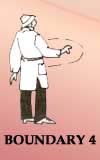
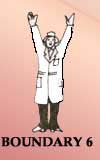

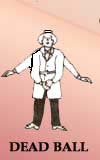
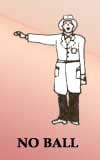
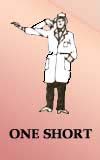
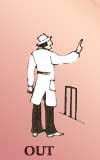
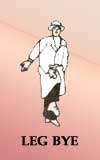
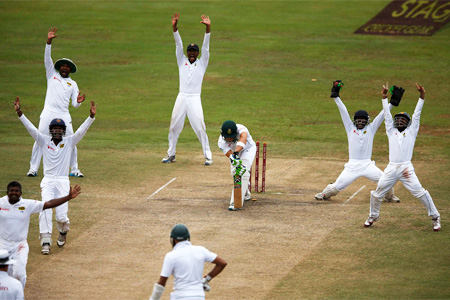
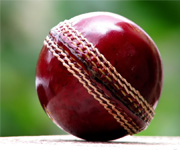
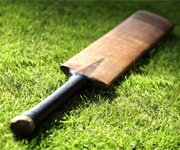
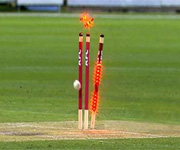
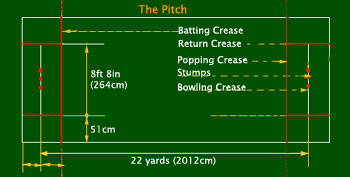
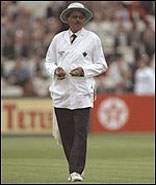 Two umpires are appointed one on each end (bowlers end and strikers end) to control the game. The umpires shall take positions from where they can easily see any act upon which their decision may be required. The umpire at the strikers end may elect to stand on the off instead of leg side of the pitch. The umpires shall change the ends after each side has had one innings.
Two umpires are appointed one on each end (bowlers end and strikers end) to control the game. The umpires shall take positions from where they can easily see any act upon which their decision may be required. The umpire at the strikers end may elect to stand on the off instead of leg side of the pitch. The umpires shall change the ends after each side has had one innings.